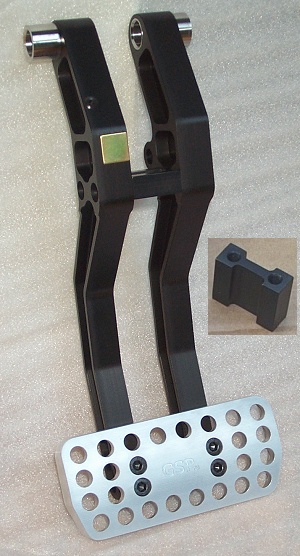|
| |||||||||
| |||||||||
|
|
|
|
| |||||||||
| |||||||||
|
|

| |||||||
|
As mentioned, the brake pedal itself required the most attention so that its mass could be reduced to the highest degree possible. This was necessary since the pedal, located furthest from the pivot point under the dash, contributes most to the rotational inertia of the pedal assembly. But even though mass was being removed from the pedal by all available means, the part also had to remain very stiff. And not just stiff in any arbitrary directions. The pedal had to be stiff in the directions that would allow it to resist the particular loads imparted by this P7 brake setup. In this instance the distortion modes that the pedal had to resist were in-plane shear (to prevent the brake arms moving side-to-side) and out-of-plane bending along the pedal's major axis (to prevent the left brake arm moving towards the firewall without the right). The final pedal design shown above reveals the end result of these multiple requirements. The backside of the pedal is heavily machined to remove mass. But a ridge is left around the outer periphery of the pedal to add stiffness. The center portion of the pedal is reasonably thick, but half inch diameter holes are drilled through most of the pedal to remove mass (with a minimal effect on stiffness). The front surface of the P7 pedal is contoured to the same radius as the factory rubber brake pedal pad. This is done so that the pedal feels completely natural to the driver, and to reduce potential pressure points on the bottom of the foot. | |||||||
 Another key design element which contributes to the stiffness of the P7 pedal is the "bridge" connecting the left
and right brake arms. This bridge is vital in transferring brake force from the left arm over
to the right arm (which actually pushes against the brake master cylinder).
Another key design element which contributes to the stiffness of the P7 pedal is the "bridge" connecting the left
and right brake arms. This bridge is vital in transferring brake force from the left arm over
to the right arm (which actually pushes against the brake master cylinder).
The way that the bridge is used allows it to act as a shear plane between the two pedal arms. For this reason it can be made quite thin and yet still serve its purpose. The bridge is located some distance from the brake pedal pivot point so mass savings remain beneficial in this region. The net result of using the bridge in this fashion is that the P7 brake arms are tied together at three points; (1) the pivot point on the pedal cluster, (2) the bridge, and (3) the brake pedal itself. This ensures that whether the driver presses on the right side or the left side of the pedal surface, the brake arms will move as one, and negligible flex will be felt in the system. As can be seen in the photo on the left, the pivot sleeves are machined from stainless steel. They were very carefully sized and chamfered to reduce friction at the brake pedal pivot point without inducing any play. The pivot tubes accept the standard factory plastic bushings. The Cadmium plated square on the left brake arm is a ferrous trigger for the Hall effect brake light switch. A new bracket was designed to locate the switch. The reader may still be wondering at this point - why all this fuss about left foot braking? Next page ... | |||||||
|
| |||||||
|
|
|